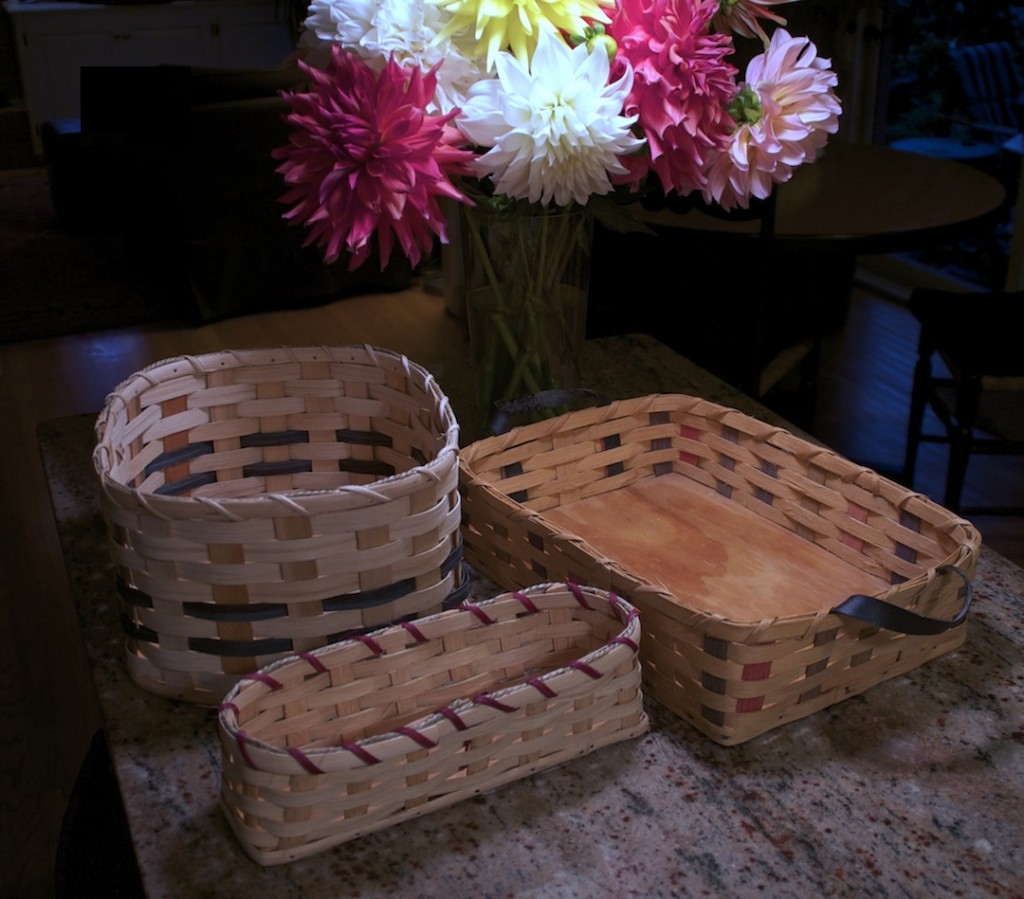Baskets lost and found
I’ve been doing still life paintings since the 80s, and I’ve tended to rely on fairly common household objects: jars, pitchers, napkins, flowers, fruit, all standard fare. OK, now and then, a skull, but skulls are as traditional as you can get in Western art. Like Chardin, I return again and again to a limited set of objects. We owned a couple baskets years ago—one of them survives in my wife’s classroom at School #43 in the city of Rochester, but we lost the other one in our last move. I’m reminded of that lost basket every time I visit my parents at their place in Florida, where a painting of it hangs in their dining room. Thinking about a show I’m preparing for next year, I wondered if I could find something like that lost basket on the Web, and I began a search using various words until for some reason I remembered that the style of that basket was Amish.
I found www.amishbasketweaver.com and picked out three baskets that were as close as I could get to the one I’d painted before. The site sells crafts from an Amish community in Tennessee. (Two of the baskets are in the photo above, on the left; the larger one on the right I found on eBay.) So I ordered the baskets and forgot about them for a few weeks. When I realized the baskets hadn’t arrived, I wrote a friendly note asking if things were still on track. Lydia, who wrote back, hinted that a particular person was still weaving them for me: Mary Mast. I said there was no rush. A week or two later, the baskets arrived in an old, spavined box, nestled in egg cartons, in perfect condition.
I wrote back to Lydia: “The baskets arrived today. Beautiful work. Thanks very much.”
She replied: “I’m happy you are pleased with Mary’s workmanship.”
“Definitely,” I said. “My compliments to Mary.”
I think those few additional words for some reason triggered what came next, which completely changed the way I look at those baskets now, sitting on our kitchen counter.
“Thank you so much for your compliments—I will be sure to tell Mary when next I see her. She is a widow with nine children; Alvin died a year ago this past July—her only income is making baskets and selling her baked goods. Mary is a very inspirational human being—Alvin was permanently disabled in a farming accident 13 years ago, and Mary was the devoted wife, taking care of him, the farm and the children. She never complained about her lot in life, but is so incredibly loving and tender-hearted. She epitomizes ‘selflessness’. While Alvin was still alive, she would take care of him on Saturday mornings, load up her buggy before daybreak with all her baked and canned goods, and her baskets and make the six mile trip to the Amish Auction barn. Once there, she had to set up her tables and load these with her goods to sell to the tourists. She did this every Saturday regardless of weather, because their farm is so far off the beaten path, the tourists never find them. We set up the amishbasketweaver.com website to help her sell some of her baskets after Alvin’s accident—it is something of a nuisance trying to find boxes for shipping, but if it helps this struggling family, it is worth the work—it certainly doesn’t come close to comparing to the load Mary must carry.”
This was so moving, and unexpected, that I wasn’t quite sure what to write back, but I eventually told Lydia that I would share with Mary something of whatever I earn from paintings of the baskets. She wrote back:
“If you return to our website, we have a market basket there that is a gorgeous example of the basket maker’s art. Levi Yoder makes these—he is totally blind. His wife, Lydia, makes the basket form and gets him started with the reed, and then he weaves the basket and even covers the handle in beautiful woven work. He told me that market baskets were once a sign of the prosperity of the household, so basket makers made these to show off their best craftsmanship in this medium. Yes, there are a lot of people who can inspire us to be more grateful for the lack of tragedy in our lives, to encourage us . . . in spite of disappointment or hardship. This Amish community is full of people who stoke the human soul with their courage and commitment, that go on in the face of adversity and persevere—it is extremely soulful and inspiring to live here.”

Comments are currently closed.